Most innovative companies for 08/06/2024 (new inventions)
Exciting new inventions from Qualcomm Incorporated, Samsung Electronics Co., Ltd., Lg Electronics Inc. And Huawei Technologies Co., Ltd.
This is a weekly article summarizing a handful of inventions from the most innovative companies in the world. The summaries are created by an A. I. and proof-read by a human before publication. Attempts are made to ensure accuracy of the descriptions, but it is very much a work in progress. Each invention description is preceeded by a poem about the invention that is written by the A. I. I have found the limerick is actually quite good at explaining the invention in simple terms. Enjoy!
****
"Revolutionizing Shovels: Patent Introduces Innovative Modular Design for Enhanced Functionality"
What is this invention?
Detectorist shovel device
There once was a shovel so neat,
With parts that all seemed quite complete,
Blade, shaft, grip, and more,
All made to explore,
Innovations that make it elite.
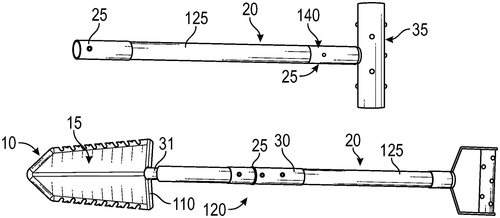
In a recent patent filing, a new and innovative shovel design has been described, boasting features such as a blade, a shaft, a handle, a handgrip, and a unique coupling component. The handgrip, strategically positioned at the center of weight of the shovel, ensures balanced weight distribution for enhanced usability. The angled orientation of the shaft relative to the blade and handle adds a modern twist to traditional shovel designs. One of the key highlights of this invention is the coupling component, allowing for easy assembly and disassembly of modular sections of the shaft. This feature could potentially revolutionize the way shovels are transported and stored, making it a compelling option for outdoor enthusiasts and DIY enthusiasts. Despite the intriguing description, it remains to be seen whether this unique shovel design will make its way into the market and compete with established brands. Could this innovative shovel design pave the way for a new era of customizable and portable tools? Share your thoughts in the comments below!
Abstract
While the described shovel can include any suitable component, in some cases, it includes a blade, a shaft, a handle, a handgrip, and/or a coupling component. In some cases, the handgrip is located at a center of weight of the shovel, with substantially half of the shovel's weight distributed on each side of the handgrip. In some cases, the shaft is oriented at an angle relative to the blade and the handle is oriented at an angle relative to the shaft. In some cases, the coupling component is located along the shaft and is configured to selectively and removably connect at least a first modular section of the shaft to a second modular section of the shaft. In some cases, the coupling component is configured to only fully engage when the first and second modular sections are in a single orientation with respect to each other. Other implementations are described. While the described shovel can include any suitable component, in some cases, it includes a blade, a shaft, a handle, a handgrip, and/or a coupling component. In some cases, the handgrip is located at a center of weight of the shovel, with substantially half of the shovel's weight distributed on each side of the handgrip. In some cases, the shaft is oriented at an angle relative to the blade and the handle is oriented at an angle relative to the shaft. In some cases, the coupling component is located along the shaft and is configured to selectively and removably connect at least a first modular section of the shaft to a second modular section of the shaft. In some cases, the coupling component is configured to only fully engage when the first and second modular sections are in a single orientation with respect to each other. Other implementations are described.
US Patent 12052937
****
"Revolutionary Patent Introduces Fully Rotating Rotary Actuator for Multi-Purpose Machines"
What is this invention?
Fully rotating rotary device
There once was a machine so fine
With a fully rotating design
A rotary actuator reigned supreme
With joints that could spin and gleam
A marvel of technology's line
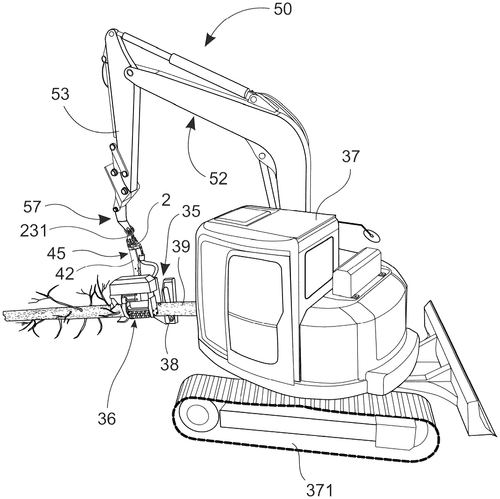
A newly patented fully rotating rotary actuator for multi-purpose machines promises to revolutionize the way felling heads are supported and operated. Unlike traditional models that offer limited rotational capabilities, this innovative design features a rotary mechanism driven by a motor, allowing for full 360-degree rotation. Competitors in this space, such as traditional hydraulic actuators, might soon find themselves outmatched by this new technology. Imagine the possibilities in forestry, construction, or even robotics where precise and unrestricted rotational movement is crucial. The inclusion of conduits for electrical cables and fluid lines further enhances the functionality of this actuator, making it a versatile solution for various applications. The ability to apply additive fluids opens up even more opportunities for customization and efficiency. But will this groundbreaking technology make its way from the patent office to production lines? How will industries adapt to the potential disruptions this innovation may bring? Share your thoughts in the comments below.
Abstract
Fully rotating rotary actuator of a multi-purpose machine in which an axle supports the frame of a felling head by a bearing mount, there being a rotary mechanism driven by a rotary motor between the axle and the frame, and in which the connection of the axle includes rotatable joints, the axle includes conduits for electrical cables and a processing fluid line, and in which an additive fluid line tube is arranged in the conduit in the axle and connected to its lower end is a rotatable connector, which is connected to a second tube fastened in the frame for the application of the additive fluid. Fully rotating rotary actuator of a multi-purpose machine in which an axle supports the frame of a felling head by a bearing mount, there being a rotary mechanism driven by a rotary motor between the axle and the frame, and in which the connection of the axle includes rotatable joints, the axle includes conduits for electrical cables and a processing fluid line, and in which an additive fluid line tube is arranged in the conduit in the axle and connected to its lower end is a rotatable connector, which is connected to a second tube fastened in the frame for the application of the additive fluid.
US Patent 12052952
****
"New Patent Revolutionizes Water Flow in Corner Arm Sprinklers for Precise Field Irrigation"
What is this invention?
System, method and apparatus for computing and managing the flow rate within an irrigation corner assembly
There once was a system so fine,
Calculating the water flow line.
Corner arm sprinklers in play,
Balancing flow rates all day,
Innovation at work, oh so divine.
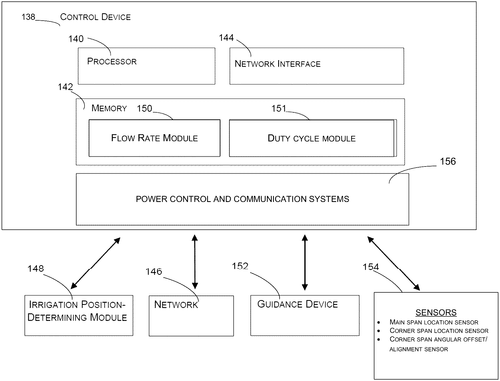
A new patent has been granted for a system and method designed to revolutionize water flow rates in corner arm sprinklers. This innovative technology aims to provide precise and uniform water distribution across fields, a capability that could potentially outperform current competitor products on the market. Imagine the possibilities of this invention in agricultural settings, where efficient and targeted water distribution is essential for crop growth. By controlling and balancing the flow rates of corner arm sprinklers, farmers could see improved yields and reduced water waste. Will this patent lead to a practical solution for optimizing water usage in agriculture? How might this technology impact the future of sustainable farming practices? Let us know your thoughts in the comments below.
Abstract
The present invention provides a system and method for calculating the water flow rates applied by corner arm sprinklers. According to a first embodiment, the present invention provides a system and method for controlling and balancing the flow rates of corner arm sprinklers to provide targeted discrete, controlled uniform and non-uniform water distribution rates across a given field. The present invention provides a system and method for calculating the water flow rates applied by corner arm sprinklers. According to a first embodiment, the present invention provides a system and method for controlling and balancing the flow rates of corner arm sprinklers to provide targeted discrete, controlled uniform and non-uniform water distribution rates across a given field.
US Patent 12052955
****
"Revolutionizing Agriculture: Patent Unveils Innovative Maize Variety X08T848 and Advanced Genetic Modification Techniques"
What is this invention?
Maize hybrid X08T848
In the world of maize so fine, X08T848 does shine,
Created by crossing, a variety divine,
Traits introgressed through engineering design,
Methods and methods all intertwined,
A marvel of technology in agriculture's line.

A new patent has been filed for a novel maize variety known as X08T848, which has been developed through the crossing of inbred maize varieties. This new variety shows promise in potentially introducing new traits into the genetic material of maize plants through backcrossing or genetic transformation. With the agricultural industry constantly seeking to improve crop yields and resilience, the development of maize varieties like X08T848 could lead to advancements in the field. Competitors in the market, such as established seed companies known for their genetically modified maize products, may find themselves facing new competition if this variety proves successful. Imagine the possibilities of utilizing X08T848 in creating maize plants with enhanced traits such as disease resistance, increased nutritional value, or improved yield potential. Farmers could potentially benefit from planting this new variety, leading to more sustainable farming practices and higher productivity. As we await further developments on the potential commercialization of X08T848, it raises the question: How important is genetic innovation in agriculture, and what are the ethical considerations surrounding the use of genetically modified crops? Share your thoughts in the comments below.
Abstract
A novel maize variety designated X08T848 and seed, plants and plant parts thereof are produced by crossing inbred maize varieties. Methods for producing a maize plant by crossing hybrid maize variety X08T848 with another maize plant are disclosed. Methods for producing a maize plant containing in its genetic material one or more traits introgressed into X08T848 through backcrossing or genetic transformation, and to the maize seed, plant and plant part produced thereby are described. Maize variety X08T848, the seed, the plant produced from the seed, and variants, mutants, and minor modifications of maize variety X08T848 are provided. Methods for producing maize varieties derived from maize variety X08T848 and methods of using maize variety X08T848 are disclosed. A novel maize variety designated X08T848 and seed, plants and plant parts thereof are produced by crossing inbred maize varieties. Methods for producing a maize plant by crossing hybrid maize variety X08T848 with another maize plant are disclosed. Methods for producing a maize plant containing in its genetic material one or more traits introgressed into X08T848 through backcrossing or genetic transformation, and to the maize seed, plant and plant part produced thereby are described. Maize variety X08T848, the seed, the plant produced from the seed, and variants, mutants, and minor modifications of maize variety X08T848 are provided. Methods for producing maize varieties derived from maize variety X08T848 and methods of using maize variety X08T848 are disclosed.
US Patent 12052962
****
"Futuristic Pet Crate Bumper Revolutionizes Comfort and Fit in Pet Crates"
What is this invention?
Universal pet crate bumper
In a pet crate, a gadget so fine,
A bumper designed to align,
With panels stitched snug,
Compact batting like a rug,
Keeps the crate looking perfectly prime.
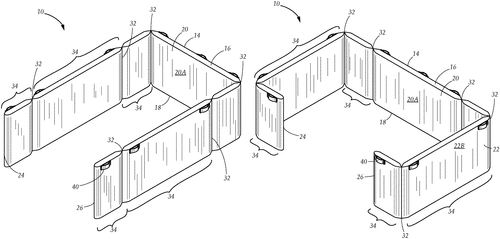
A new patent has been filed for a universal pet crate bumper that aims to revolutionize the way we care for our furry friends during travel or confinement. This innovative product features a unique design with vertical lines of stitching that allow the bumper to fold neatly into the corners of a pet crate. The dense structure of the internal batting ensures that the bumper maintains its upright position along the crate's sidewalls, providing comfort and security for pets. While this invention promises to enhance the safety and comfort of pets in crates, it faces potential competition from existing pet crate accessories in the market. Competitor products may offer similar functionalities, making it crucial for this universal pet crate bumper to stand out with its distinct features and benefits. Imagine the convenience of using this bumper to create a cozy and secure environment for your pet during travel or training sessions. With its compact design and sturdy construction, it could potentially become a must-have accessory for pet owners seeking to improve their pets' crate experience. Will this universal pet crate bumper pave the way for a new era of pet care accessories, or will it struggle to distinguish itself in a competitive market? Share your thoughts in the comments below.
Abstract
A universal pet crate bumper includes a body having an upper end, a lower end, a front, a rear, an internal batting spanning the length and width of the body, an outer fabric layer enclosing the batting, and at least four vertical lines of stitching extending from the upper end to the lower end and through the batting from the front to the rear. The vertical lines of stitching compress the batting to form distinct panels along the body that correspond to the sidewalls of a pet crate. The lines of stitching define a pivot upon which the body may fold at least 90 degrees such that the body may fit snuggly within the corners of the pet crate. The batting includes a compact and dense structure enabling the body to maintain an upright orientation along the sidewalls of the pet crate without sagging when the bumper is installed. A universal pet crate bumper includes a body having an upper end, a lower end, a front, a rear, an internal batting spanning the length and width of the body, an outer fabric layer enclosing the batting, and at least four vertical lines of stitching extending from the upper end to the lower end and through the batting from the front to the rear. The vertical lines of stitching compress the batting to form distinct panels along the body that correspond to the sidewalls of a pet crate. The lines of stitching define a pivot upon which the body may fold at least 90 degrees such that the body may fit snuggly within the corners of the pet crate. The batting includes a compact and dense structure enabling the body to maintain an upright orientation along the sidewalls of the pet crate without sagging when the bumper is installed.
US Patent 12052975
QUALCOMM Incorporated
"QUALCOMM Patent Revolutionizes Time Error Detection in Navigation Systems"
What is this invention?
Erroneous time and location detection and correction
In the realm of tech and its wires,
Systems detect timing errors, not liars.
With navigation in play,
Timestamps lead the way,
Ensuring precise time never tires.
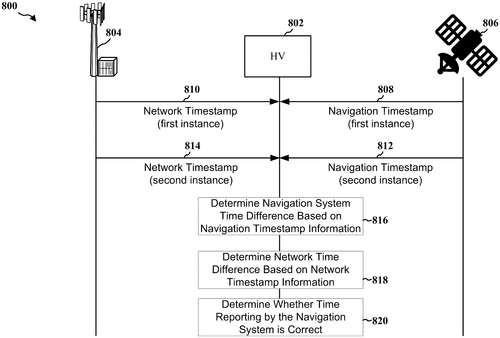
An innovative patent from QUALCOMM Incorporated has surfaced, introducing systems and techniques for detecting timing errors. The technology involves comparing timestamp information from a navigation system and a wireless device to determine discrepancies in time reporting accuracy. This advancement could potentially enhance the reliability and precision of location-based services, such as GPS navigation. Competitors in the navigation and telecommunications industries, such as Garmin and Apple, may need to take note of this development to stay ahead in the game. The ability to detect and rectify timing errors could lead to more seamless and accurate location-based applications, benefiting users in various scenarios from driving directions to asset tracking. The practical applications of this patent are promising, but the big question remains: Will this innovative technology be integrated into commercial products in the near future? How do you envision this advancement shaping the future of navigation systems and wireless communication? Share your thoughts in the comments section below.
Abstract
Systems and techniques are described for detecting one or more timing errors. For example, a system can receive, from a navigation system, navigation timestamp information at a first instance and a second instance. The system can determine a navigation system time difference based on the navigation timestamp information at the first instance and the second instance. The system can further receive, from a wireless device, network timestamp information at the first instance and the second instance. The system can determine a network time difference based on the network timestamp information at the first instance and the second instance. The system can further determine whether time reporting by the navigation system is correct based on the navigation system time difference and the network time difference. Systems and techniques are described for detecting one or more timing errors. For example, a system can receive, from a navigation system, navigation timestamp information at a first instance and a second instance. The system can determine a navigation system time difference based on the navigation timestamp information at the first instance and the second instance. The system can further receive, from a wireless device, network timestamp information at the first instance and the second instance. The system can determine a network time difference based on the network timestamp information at the first instance and the second instance. The system can further determine whether time reporting by the navigation system is correct based on the navigation system time difference and the network time difference.
US Patent 12055640
QUALCOMM Incorporated
"Qualcomm's New Patent Enhances Data Storage Device Memory Utilization with Multiple Write Buffers"
What is this invention?
Write buffer and logical unit management in a data storage device
In the realm of storage so vast and grand,
Techniques aplenty at our command,
Memory resources we optimize with glee,
Write buffers and arrays make data flow free,
Efficiency reigns in this digital land.
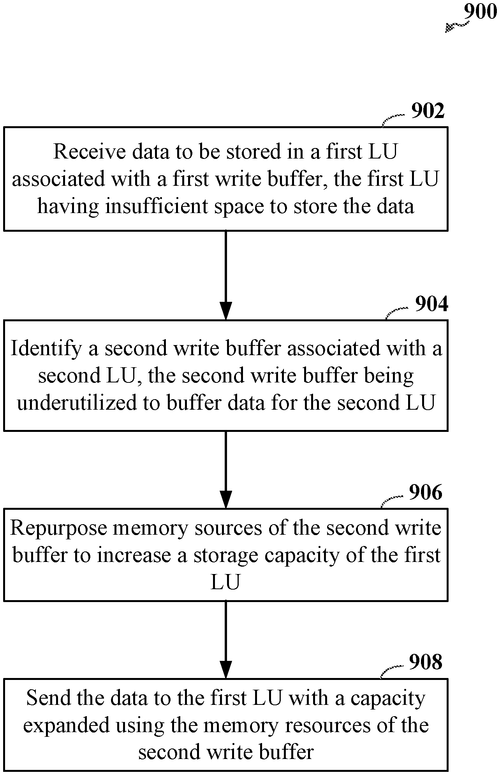
In this patent from QUALCOMM Incorporated, they discuss innovations in improving memory resource utilization for data storage devices using nonvolatile memory (NVM). By implementing multiple write buffers and a utilization array to track buffer usage, the device aims to enhance write throughput and efficiency. One intriguing feature is the ability to repurpose memory from underutilized buffers to support active logical units, potentially optimizing storage performance. Competitors in the data storage industry, such as Samsung and Western Digital, may take note of these advancements and consider how to adapt their own technologies to remain competitive in the market. Imagine the possibilities of faster, more efficient data storage systems in various applications, from smartphones to data centers. Could this innovation pave the way for a new standard in memory management across devices? Share your thoughts in the comments below.
Abstract
Aspects of the present disclosure provide various techniques, apparatuses, and methods that can improve the memory resource utilization of a data storage device that uses nonvolatile memory (NVM) to store data. In some aspects, the data storage device can be provided with multiple write buffers to improve the write throughput of the device. In some aspects, the data storage device can use a utilization array to keep track of the utilization information of each write buffer. In some aspects, the data storage device can repurpose the memory of a write buffer with low utilization to serve an active logical unit which becomes full, thus preserving the function of the write buffer of the active logical unit. Aspects of the present disclosure provide various techniques, apparatuses, and methods that can improve the memory resource utilization of a data storage device that uses nonvolatile memory (NVM) to store data. In some aspects, the data storage device can be provided with multiple write buffers to improve the write throughput of the device. In some aspects, the data storage device can use a utilization array to keep track of the utilization information of each write buffer. In some aspects, the data storage device can repurpose the memory of a write buffer with low utilization to serve an active logical unit which becomes full, thus preserving the function of the write buffer of the active logical unit.
US Patent 12056364
QUALCOMM Incorporated
"Innovative Method for Enhanced Data Processing with Qualcomm's New Memory Module"
What is this invention?
Inference in memory
In a world of enhanced memory, so fine,
Data processing is done in a line,
From host to core, it flows,
Generating results that glows,
A technological marvel, one of a kind.
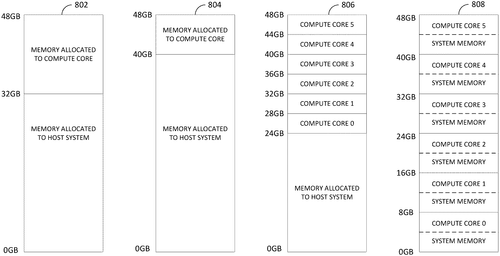
In a bid to revolutionize data processing, QUALCOMM Incorporated has patented a method that combines a compute core with an enhanced memory module. This innovative approach involves transferring data from a host processing system to the enhanced memory module, processing it with the compute core, and then sending the processed data back to the host system for use. Competitors in the tech industry, such as Intel and NVIDIA, offer similar processing solutions, but QUALCOMM's method appears to streamline the process by integrating the compute core directly into the memory module. The potential uses for this technology could span across various sectors, from improving the speed and efficiency of data analysis in artificial intelligence to enhancing the performance of gaming consoles. However, as exciting as this patent sounds, the question remains: Will QUALCOMM be able to translate this concept into a tangible product that can impact the market? How do you envision this innovation influencing the future of data processing and computation? Leave your thoughts in the comments below.
Abstract
Certain aspects of the present disclosure provide a method for processing data with an enhanced memory module comprising a compute core, including: receiving data at the enhanced memory module from a host processing system; storing the data in host processing system-addressable memory; transferring the data from the host processing system-addressable memory to compute core-addressable memory; processing the data with the compute core on the enhanced memory module to generate processed data; transferring the processed data from the compute core-addressable memory to the host processing system-addressable memory; and providing the processed data to the host processing system via the host processing system-addressable memory. Certain aspects of the present disclosure provide a method for processing data with an enhanced memory module comprising a compute core, including: receiving data at the enhanced memory module from a host processing system; storing the data in host processing system-addressable memory; transferring the data from the host processing system-addressable memory to compute core-addressable memory; processing the data with the compute core on the enhanced memory module to generate processed data; transferring the processed data from the compute core-addressable memory to the host processing system-addressable memory; and providing the processed data to the host processing system via the host processing system-addressable memory.
US Patent 12056382
QUALCOMM Incorporated
"QUALCOMM Patent Unveils Next-Gen Convolutional Neural Network Innovation"
What is this invention?
Compute in memory architecture and dataflows for depth-wise separable convolution
In arrays of CIM, a method so neat,
With layers of kernels, a marvel complete,
Depthwise and fused, they do meet,
Pre-activations dance in their own beat,
New technology, creating a feat.
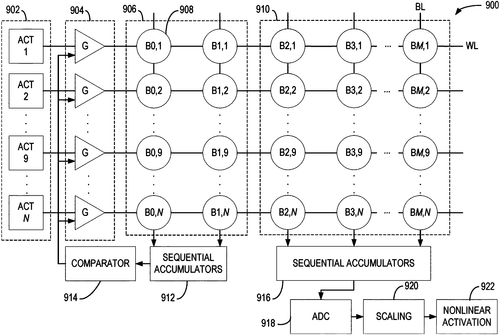
A recent patent from QUALCOMM Incorporated showcases a method that involves storing complex convolution kernels in a unique array system to process pre-activations and generate output in a more efficient manner. This innovative approach puts QUALCOMM in direct competition with tech giants like NVIDIA and Intel who also work on advanced processing technologies. The potential uses for this invention are vast, ranging from improving image and speech recognition systems to enhancing facial recognition technology. By streamlining the convolution process, this method could lead to faster and more accurate results in various applications. But the big question remains: Will QUALCOMM be able to turn this patent into a practical product that revolutionizes the tech industry? Let us know your thoughts in the comments below.
Abstract
Certain aspects of the present disclosure provide a method, including: storing a depthwise convolution kernel in a first one or more columns of a CIM array; storing a fused convolution kernel in a second one or more columns of the CIM array; storing pre-activations in one or more input data buffers associated with a plurality of rows of the CIM array; processing the pre-activations with the depthwise convolution kernel in order to generate depthwise output; modifying one or more of the pre-activations based on the depthwise output to generate modified pre-activations; and processing the modified pre-activations with the fused convolution kernel to generate fused output. Certain aspects of the present disclosure provide a method, including: storing a depthwise convolution kernel in a first one or more columns of a CIM array; storing a fused convolution kernel in a second one or more columns of the CIM array; storing pre-activations in one or more input data buffers associated with a plurality of rows of the CIM array; processing the pre-activations with the depthwise convolution kernel in order to generate depthwise output; modifying one or more of the pre-activations based on the depthwise output to generate modified pre-activations; and processing the modified pre-activations with the fused convolution kernel to generate fused output.
US Patent 12056459
QUALCOMM Incorporated
"Revolutionizing Wireless Communication: Qualcomm's Innovative Neural Network Methodology"
What is this invention?
Gradient feedback framework for joint transceiver neural network training
In the realm of wireless communication,
Devices speak in pure coordination.
Transmission points and gradients they reveal,
Transmitting messages with utmost zeal.
Neural networks and payloads in vibration.
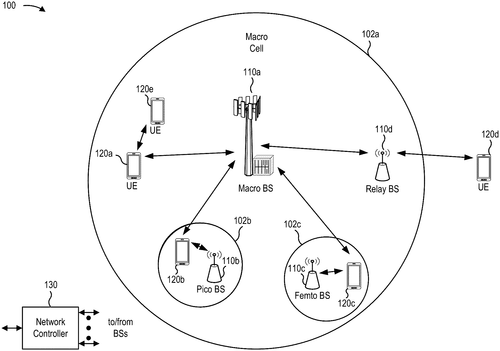
A new patent filed by QUALCOMM Incorporated promises to revolutionize wireless communication through a method that involves neural networks and loss gradients. This innovative approach aims to enhance the efficiency and reliability of data transmission between receiving and transmitting devices. Competitors in the wireless communication industry, such as Apple and Samsung, may need to take note of this cutting-edge technology as it could potentially offer a significant advantage in terms of speed and data transfer quality. Imagine a world where your devices seamlessly communicate with each other without any interference or delay, thanks to this patented method. But the big question remains: Will this method of wireless communication ever see the light of day in actual products? While the concept is undoubtedly exciting, the road from patent to product is often long and challenging. How do you think this technology could transform the way we communicate wirelessly in the future? Share your thoughts in the comments below.
Abstract
A method of wireless communication performed by a receiving device includes determining a transmission reference point value and determining a transmission reference point gradient of a loss based on the transmission reference point value. The receiving device also transmits a message comprising the transmission reference point gradient to a transmitting device. A method of wireless communication by a transmitting device includes receiving a transmission reference point gradient of a loss from a receiving device. The transmitting device determines a transmission point-payload gradient of a transmission reference point value with respect to an encoded value generated by a transmitter neural network. The transmitting device also determines a payload gradient of the loss based on a product of the transmission reference point gradient and the transmission point-payload gradient. The transmitting device further updates weights of the transmitter neural network based on the payload gradient. A method of wireless communication performed by a receiving device includes determining a transmission reference point value and determining a transmission reference point gradient of a loss based on the transmission reference point value. The receiving device also transmits a message comprising the transmission reference point gradient to a transmitting device. A method of wireless communication by a transmitting device includes receiving a transmission reference point gradient of a loss from a receiving device. The transmitting device determines a transmission point-payload gradient of a transmission reference point value with respect to an encoded value generated by a transmitter neural network. The transmitting device also determines a payload gradient of the loss based on a product of the transmission reference point gradient and the transmission point-payload gradient. The transmitting device further updates weights of the transmitter neural network based on the payload gradient.
US Patent 12056609
Samsung Electronics Co., Ltd.
"Samsung's Display Apparatus Innovates Device Control Compatibility"
What is this invention?
Display apparatus and operating method thereof
In the world of display apparatus grand,
A method is there to command.
Processor and memory, oh so fine,
Controller and device align.
Converting signals, in sync they stand.
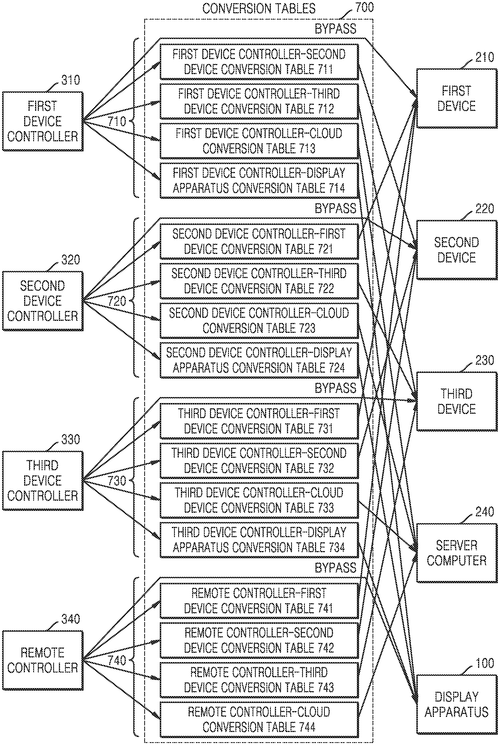
Samsung Electronics Co., Ltd. has recently patented a display apparatus and operating method that aims to streamline device compatibility and control. This innovation involves identifying device controllers and devices activated on the display, determining their compatibility, and efficiently managing control signals. In a world where smart devices are increasingly interconnected, the ability to seamlessly control various gadgets with a display could revolutionize user experience. Imagine being able to effortlessly switch between controlling your smart TV, gaming console, and home assistant from a single interface. Competitors like Apple and Google have made strides in integrating smart home devices, but Samsung's approach seems to focus on simplifying the control process. The technology described in the patent has the potential to bridge the gap between different device standards, offering a one-size-fits-all solution for users. While this patent showcases Samsung's commitment to innovation, the real question remains: Will this technology be translated into a consumer product anytime soon? How would you envision incorporating this unified control system into your daily life? Share your thoughts below.
Abstract
Provided are a display apparatus and/or an operating method thereof. The display apparatus may include: a display; a memory storing one or more instructions; and at least one processor configured to execute the one or more instructions stored in the memory to identify a device controller activated on the display apparatus and a device activated on the display apparatus, determine whether the identified device controller is compatible with the identified device, control, when it is determined that the identified device controller is compatible with the identified device, a control signal from the device controller to be directly provided to the device, and convert, when it is determined that the identified device controller is incompatible with the identified device, the control signal from the device controller into a control signal recognizable by the device, and control the converted control signal to be provided to the device. Provided are a display apparatus and/or an operating method thereof. The display apparatus may include: a display; a memory storing one or more instructions; and at least one processor configured to execute the one or more instructions stored in the memory to identify a device controller activated on the display apparatus and a device activated on the display apparatus, determine whether the identified device controller is compatible with the identified device, control, when it is determined that the identified device controller is compatible with the identified device, a control signal from the device controller to be directly provided to the device, and convert, when it is determined that the identified device controller is incompatible with the identified device, the control signal from the device controller into a control signal recognizable by the device, and control the converted control signal to be provided to the device.
US Patent 12053692
Samsung Electronics Co., Ltd.
"Samsung Patents Revolutionary Outdoor Air Cleaning System with Adjustable Openness Level"
What is this invention?
Outdoor air cleaning system
In a world of fresh air, oh so grand,
An outdoor system takes its stand,
With a partition's divide,
Purifying air inside,
Controlled by the touch of a hand.
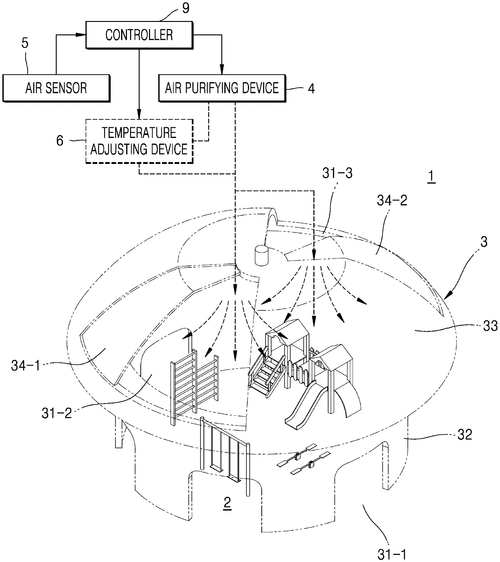
Samsung Electronics Co., Ltd. has recently patented an outdoor air cleaning system that aims to purify the surrounding air in a novel way. The system features a partition that separates the purification space from the external environment, with openings allowing for purified air to flow in and out. The air purifying device within the system is controlled by a controller for efficient operation. Competitors in the market, such as Dyson and Blueair, offer similar indoor air purifying solutions, but Samsung's outdoor system could potentially revolutionize the way we clean the air in open spaces. Imagine parks, playgrounds, and outdoor events benefiting from this technology, creating healthier environments for everyone. Will we see Samsung's outdoor air cleaning system on the market anytime soon? How could this invention impact public health and urban planning in the future? Share your thoughts in the comments below.
Abstract
An outdoor air cleaning system includes a partition surrounding a purification space to isolate the purification space from an external space and having at least one opening connecting the purification space to the external space, an air purifying device configured to supply purified air to the purification space, and a controller configured to control the air purifying device. An openness level defined as an area ratio of the opening with respect to a surface area of the partition is about 10% or more and about 50% or less. An outdoor air cleaning system includes a partition surrounding a purification space to isolate the purification space from an external space and having at least one opening connecting the purification space to the external space, an air purifying device configured to supply purified air to the purification space, and a controller configured to control the air purifying device. An openness level defined as an area ratio of the opening with respect to a surface area of the partition is about 10% or more and about 50% or less.
US Patent 12055320
Samsung Electronics Co., Ltd.
"Innovative Navigation Apparatus Patent by Samsung Enhances GPS Accuracy"
What is this invention?
Navigation apparatus and operation method of navigation apparatus
In a navigation apparatus so neat,
GPS data makes the directions complete.
The method to follow,
From map elements to swallow,
Pose parameter determined, victory sweet.

Samsung Electronics Co., Ltd. has recently filed a patent for an operation method of a navigation apparatus that aims to enhance the accuracy of GPS data for improved navigation capabilities. The method involves obtaining GPS data at a current time point, determining neighboring map elements, and calculating a pose parameter based on specified directions from the map elements. While this innovation holds promise for more precise navigation systems, it faces stiff competition from established players such as Google Maps and Apple Maps. The potential applications of this technology could revolutionize the way we navigate in urban environments, providing real-time updates and efficient routes for users. Will Samsung be able to turn this patent into a tangible product that will disrupt the navigation market? How might this advancement impact the future of GPS technology? Share your thoughts in the comments below.
Abstract
An operation method of a navigation apparatus includes: obtaining valid global positioning system (GPS) data at a current time point corresponding to a current position of a target device; determining first neighboring map elements corresponding to a first region indicated by the valid GPS data at the current time point from among a plurality of map elements of map data; and determining a pose parameter of the target device at the current time point based on a first direction specified by at least a portion of the first neighboring map elements. An operation method of a navigation apparatus includes: obtaining valid global positioning system (GPS) data at a current time point corresponding to a current position of a target device; determining first neighboring map elements corresponding to a first region indicated by the valid GPS data at the current time point from among a plurality of map elements of map data; and determining a pose parameter of the target device at the current time point based on a first direction specified by at least a portion of the first neighboring map elements.
US Patent 12055406
Samsung Electronics Co., Ltd.
"Samsung Introduces Innovative Electronic Device with Double-sided Display and Rollable Technology"
What is this invention?
Electronic device including roller
In a device of electronic grace,
A roller spins in its place,
Cover parts detachable with ease,
Display areas wind around with such breeze,
A technological marvel we embrace.
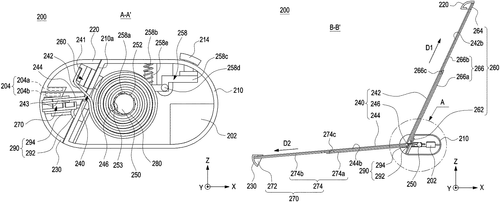
A recent patent from Samsung Electronics Co., Ltd. has unveiled a potential game-changer in the world of electronic devices. This innovation involves an electronic device with a unique feature: a display that can be wound around a roller inside the device. The device includes a housing, two detachable cover parts, and a display with two areas that can be wound around the roller. Imagine the possibilities with such a design! Users could have a portable device with a flexible display that can be easily rolled up for compact storage. This could revolutionize the way we interact with our devices, making them more portable and convenient for everyday use. Competitors in the electronics industry will surely take notice of this development, as it has the potential to disrupt the market with its innovative design. Will this patent lead to a groundbreaking new product from Samsung, or will it remain just an exciting concept on paper? What are your thoughts on the future of flexible display technology in electronic devices? Let us know in the comments below!
Abstract
According to certain embodiments of the disclosure, an electronic device may include: a housing, a roller disposed in the housing, a first cover part configured to be detachable from the housing, a second cover part configured to be detachable from the housing, and a display including a first display area including a first end coupled with the first cover part, and a second display area including a second end coupled with the second cover part, wherein at least a portion of the first display area is configured to be wound around the roller while facing at least a portion of the second display area. According to certain embodiments of the disclosure, an electronic device may include: a housing, a roller disposed in the housing, a first cover part configured to be detachable from the housing, a second cover part configured to be detachable from the housing, and a display including a first display area including a first end coupled with the first cover part, and a second display area including a second end coupled with the second cover part, wherein at least a portion of the first display area is configured to be wound around the roller while facing at least a portion of the second display area.
US Patent 12055975
Samsung Electronics Co., Ltd.
"Samsung Patent Reveals Innovative Waterproof Foldable Device with Flexible Display"
What is this invention?
Electronic device including foldable display
In a gadget of electronic grace,
A flexible display takes its place.
With waterproofing flair,
And plates that fold with care,
This device sets a tech trend pace.
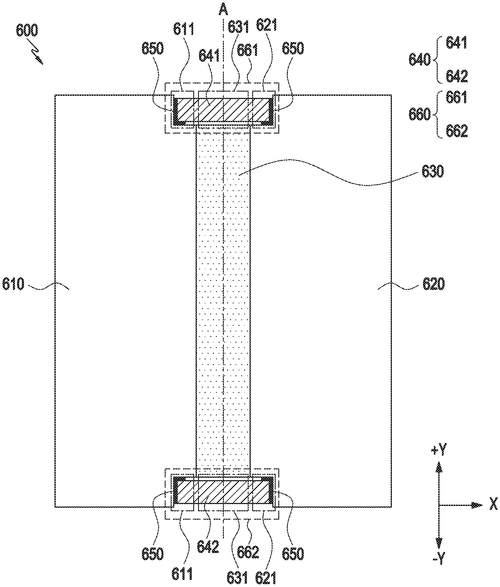
Samsung Electronics Co., Ltd. has patented an intriguing electronic device offering a unique design that includes a flexible display and waterproofing elements. The device consists of three plates that can be folded and unfolded, with the flexible display seamlessly extending across all three plates. The inclusion of waterproofing members on the ends of the device ensures protection from water damage. This innovative concept brings to mind the competition's foldable smartphones, such as the Samsung Galaxy Z Fold and the Huawei Mate X. The addition of waterproofing features sets Samsung's device apart in terms of durability and functionality. The potential uses for this device are endless. Imagine a smartphone that can be easily folded and unfolded, providing a larger screen for multimedia consumption or multitasking. The waterproofing element could make this device ideal for outdoor use or in environments where water exposure is a concern. As we contemplate the future of technology, we must ask ourselves: Will foldable devices with waterproof capabilities become the new standard in consumer electronics? Join the conversation and share your thoughts in the comments below.
Abstract
An electronic device is provided. The electronic device includes a housing including a first plate, a second plate, and a third plate connecting the first plate and the second plate to be pivotable from a folded state of the first plate and the second plate to an unfolded state, a flexible display extending from the first plate across the third plate to the second plate, and at least one waterproofing member disposed on two lengthwise opposite ends of the third plate. The first plate may include at least one first recessed portion recessed inward from at least a portion of an edge of the first plate. The second plate may include at least one second recessed portion recessed inward from at least a portion of an edge of the second plate. At least a portion of the third plate may include a portion formed in a lattice pattern. The third plate may be formed to be shorter in length than the first plate and the second plate. The at least one first recessed portion and the at least one second recessed portion may be disposed in two lengthwise opposite ends of the third plate. An electronic device is provided. The electronic device includes a housing including a first plate, a second plate, and a third plate connecting the first plate and the second plate to be pivotable from a folded state of the first plate and the second plate to an unfolded state, a flexible display extending from the first plate across the third plate to the second plate, and at least one waterproofing member disposed on two lengthwise opposite ends of the third plate. The first plate may include at least one first recessed portion recessed inward from at least a portion of an edge of the first plate. The second plate may include at least one second recessed portion recessed inward from at least a portion of an edge of the second plate. At least a portion of the third plate may include a portion formed in a lattice pattern. The third plate may be formed to be shorter in length than the first plate and the second plate. The at least one first recessed portion and the at least one second recessed portion may be disposed in two lengthwise opposite ends of the third plate.
US Patent 12055976
SAMSUNG ELECTRONICS CO., LTD.
"Samsung Patent Revolutionizes Blood Pressure Estimation with Bio-Signal Sensor Technology"
What is this invention?
Apparatus and method for estimating blood pressure
In the realm of blood pressure estimation,
An apparatus brings innovation sensation.
With sensors and processors in sync,
It delves into CO and TPR link,
Identifying post-exercise hypotension with precision calculation.
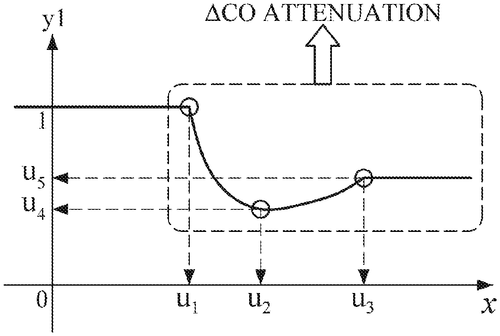
Samsung Electronics Co., Ltd. has filed a patent for an innovative apparatus aimed at estimating blood pressure through the analysis of bio-signals. The device includes a sensor to measure bio-signals, and a processor to analyze these signals and calculate key feature values related to cardiac output and total peripheral resistance. By assessing the mechanisms behind blood pressure changes, specifically post-exercise hypotension, the apparatus can accurately estimate blood pressure levels. In a market where wearable health tech is increasingly popular, with products like Fitbit and Apple Watch offering various health monitoring features, Samsung's proposed blood pressure estimator could potentially revolutionize how individuals track their cardiovascular health. Imagine being able to seamlessly monitor your blood pressure throughout the day with just a wearable device, providing real-time insights into your cardiovascular well-being. However, as with many patent filings, there is no guarantee that this apparatus will make it to the production stage. While the technology sounds promising, its practicality and effectiveness in real-world scenarios remain to be seen. Do you think personalized blood pressure estimation through wearable devices is the future of healthcare monitoring? Share your thoughts in the comments below!
Abstract
An apparatus for estimating blood pressure is provided. According to one embodiment, the apparatus for estimating blood pressure may include a sensor configured to measure a bio-signal from a subject, and a processor configured to acquire, form the bio-signal, a first feature value associated with cardiac output (CO) and a second feature value associated with total peripheral resistance (TPR), determine whether a current mechanism of blood pressure change of the subject is a post-exercise hypotension mechanism based on the first feature value and the second feature value, and estimate blood pressure according to determination of whether the current mechanism is the post-exercise hypotension mechanism. An apparatus for estimating blood pressure is provided. According to one embodiment, the apparatus for estimating blood pressure may include a sensor configured to measure a bio-signal from a subject, and a processor configured to acquire, form the bio-signal, a first feature value associated with cardiac output (CO) and a second feature value associated with total peripheral resistance (TPR), determine whether a current mechanism of blood pressure change of the subject is a post-exercise hypotension mechanism based on the first feature value and the second feature value, and estimate blood pressure according to determination of whether the current mechanism is the post-exercise hypotension mechanism.
US Patent 12053306
SAMSUNG ELECTRONICS CO., LTD.
"Samsung's Patent Fuses User's Viewpoint with Real-world Elements Through Image Processing"
What is this invention?
Image processing method of generating an image based on a user viewpoint and image processing device
In tech fields that are quite vast,
An image method brings a blast.
It generates views with ease,
Using elements to please,
Innovations forever will last.
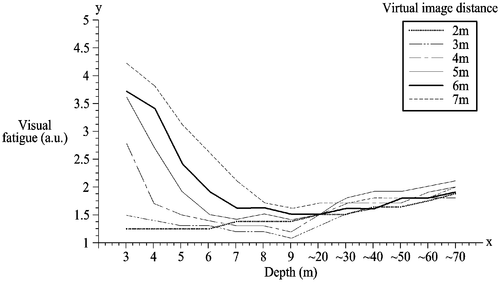
Samsung Electronics Co., Ltd. has recently patented an intriguing image processing method and device that promises to revolutionize user experience. This innovation involves generating images tailored to a user's viewpoint, overlaying information about the user's surroundings, and projecting the final image using an optical element. While this technology sounds futuristic and cutting-edge, it faces stiff competition from existing augmented reality (AR) and virtual reality (VR) products in the market. Companies like Apple and Facebook have already made strides in this field, with devices like the Apple AR glasses and Oculus VR headsets. The potential applications of Samsung's image processing invention are vast, ranging from enhancing gaming experiences to aiding in navigation and providing immersive virtual tours. Imagine walking through a museum and having relevant information about each exhibit displayed right before your eyes, or playing a video game where the characters interact with your actual environment. However, the big question remains: Will Samsung be able to bring this patented technology to the consumer market, or will it remain just another impressive concept? How do you think this invention could change the way we interact with digital content in our daily lives? Share your thoughts in the comments below.
Abstract
Provided are an image processing method and an image processing device. The image processing method includes generating an image based on viewpoint information of a user; rendering the image based on information about what is in front of the user; and outputting the rendered image using an optical element. Provided are an image processing method and an image processing device. The image processing method includes generating an image based on viewpoint information of a user; rendering the image based on information about what is in front of the user; and outputting the rendered image using an optical element.
US Patent 12054047
SAMSUNG ELECTRONICS CO., LTD.
"Samsung's Innovative Rotatable and Pushable Electronic Apparatus Revolutionizes Vehicle Functionality"
What is this invention?
Electronic apparatus and controlling method thereof
In a vehicle, an electronic delight,
With input device sleek, oh so bright,
Display shows UI for user's delight,
Profile data acquired, everything so right,
Function controlled with a push or a slight.
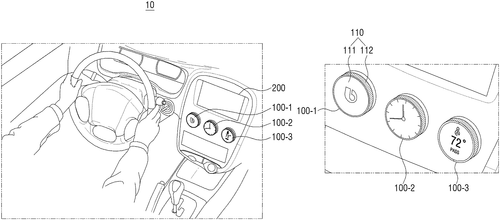
Samsung Electronics has filed a patent for an innovative electronic apparatus designed for vehicles. The apparatus features an input device that allows for both rotation and pushing, along with a display integrated within the body. A processor in the device collects user profile data related to the vehicle's functions, enabling it to display a tailored user interface on the screen. Additionally, the processor can control the vehicle's functions based on inputs received from the unique input device. This patent signals Samsung's ambition to enhance in-vehicle technology, potentially competing with existing products from companies like Tesla and BMW. The device could revolutionize the way users interact with their vehicles, offering a personalized and seamless experience. Imagine being able to customize your driving experience with just a twist or push of a button, all displayed on a sleek integrated screen. How would you envision incorporating this advanced electronic apparatus into your daily commute or road trips? Share your thoughts in the comments below.
Abstract
An electronic apparatus disposed in a vehicle is provided. The electronic apparatus includes an input device including a body configured to be rotatable and pushable and a display disposed on the body; and a processor configured to acquire profile data of a user including preset information for function of the vehicle, control the display to display basic user interface (UI) corresponding to the function of the vehicle based on the acquired profile data of the user, and control a function of the vehicle corresponding to the basic UI in response to receiving an input on the input device. An electronic apparatus disposed in a vehicle is provided. The electronic apparatus includes an input device including a body configured to be rotatable and pushable and a display disposed on the body; and a processor configured to acquire profile data of a user including preset information for function of the vehicle, control the display to display basic user interface (UI) corresponding to the function of the vehicle based on the acquired profile data of the user, and control a function of the vehicle corresponding to the basic UI in response to receiving an input on the input device.
US Patent 12054048
SAMSUNG ELECTRONICS CO., LTD.
"Revolutionizing Electroplating: Samsung's Innovative Apparatus Redefines the Plating Process"
What is this invention?
Electroplating apparatus and electroplating method
In an electroplating bath so prime,
An apparatus that stands the test of time.
With an anode and cathode region in play,
And a membrane to keep ions at bay.
With power supply unit's tech sublime.
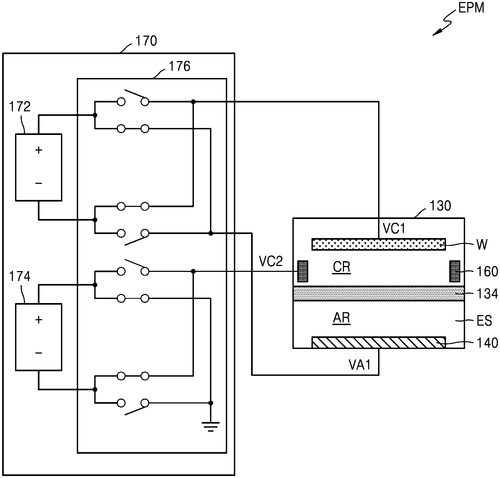
In a recent patent filed by Samsung Electronics Co., Ltd., an electroplating apparatus boasting intricate features was unveiled. This apparatus includes an electroplating bath with specific regions for different electrodes, a head unit holding the wafer in place, and a power supply unit to regulate potentials during the electroplating and rinsing processes. The inclusion of a reverse potential electrode is a standout feature, offering a unique approach to the electroplating process. Competitor's products in the electroplating industry may soon feel the pressure to innovate in response to Samsung's patent. With potential uses in semiconductor manufacturing, electronic component production, and even jewelry making, this patented apparatus could revolutionize the electroplating game. Will Samsung's electroplating apparatus pave the way for a new standard in the industry? How will other companies react to this innovative approach? Share your thoughts in the comments below.
Abstract
An electroplating apparatus includes: an electroplating bath including an anode region, in which an anode electrode is arranged, a cathode region and a membrane; a head unit including a contact ring holding a wafer and configured so that a first cathode potential is applied to the contact ring during an electroplating process; a reverse potential electrode arranged adjacent to the membrane and configured so that a second cathode potential is applied to the reverse potential electrode during the electroplating process, and a reverse cathode potential is applied to the reverse potential electrode during a rinsing process; and a power supply unit configured to apply the first cathode potential and the second cathode potential during the electroplating process, and further configured to apply the reverse cathode potential and a reverse anode potential to the anode electrode during the rinsing process. An electroplating apparatus includes: an electroplating bath including an anode region, in which an anode electrode is arranged, a cathode region and a membrane; a head unit including a contact ring holding a wafer and configured so that a first cathode potential is applied to the contact ring during an electroplating process; a reverse potential electrode arranged adjacent to the membrane and configured so that a second cathode potential is applied to the reverse potential electrode during the electroplating process, and a reverse cathode potential is applied to the reverse potential electrode during a rinsing process; and a power supply unit configured to apply the first cathode potential and the second cathode potential during the electroplating process, and further configured to apply the reverse cathode potential and a reverse anode potential to the anode electrode during the rinsing process.
US Patent 12054846
SAMSUNG ELECTRONICS CO., LTD.
"Samsung's Innovative Washing Machine Offers Adaptive Washing Options"
What is this invention?
Washing machine and method of controlling the same
In a world with tech that's advanced,
A washing machine is enhanced,
Controlled by processors smart,
Changing options with an art,
Innovative features entranced.
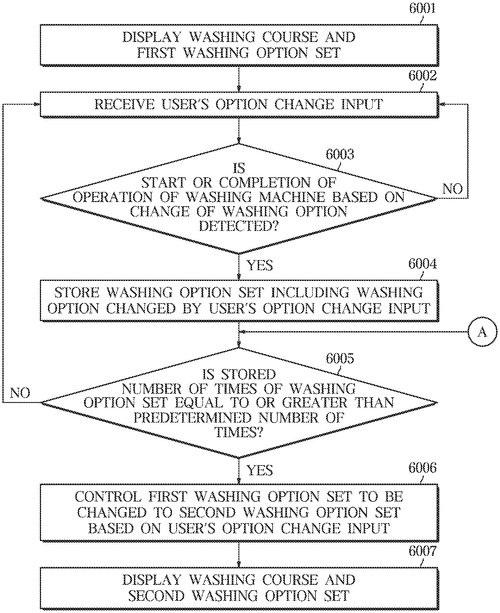
In the world of household appliances, innovation knows no bounds. Take, for example, a recent patent from Samsung Electronics Co., Ltd. for a washing machine and a method of controlling it. This hi-tech laundry appliance boasts a clever feature where users can customize their washing options through a user-friendly display and input system. What sets this invention apart is its ability to learn from user preferences - after a certain number of wash cycles, the machine will automatically adjust its settings to better suit the user's needs. Competitors in the market, such as LG and Whirlpool, may need to step up their game to match this level of personalized washing experience. Imagine never having to fiddle with complicated settings again, as your washing machine adapts to your preferences over time. This could revolutionize the way we do laundry at home, making the process more efficient and tailored to individual needs. However, as with any patent, the question remains: will this innovative concept actually make it to production and be available for consumers to purchase? Will we soon see a new era of smart washing machines that cater to our unique preferences? Share your thoughts in the comments below.
Abstract
A washing machine and a method of controlling the washing machine are provided. The washing machine includes a display configured to display a washing course and a first washing option set corresponding to the washing course, an inputter configured to receive a user's option change command for changing at least one washing option among a plurality of washing options included in the first washing option set from a user, a storage configured to store a washing option set including the changed at least one washing option, and at least one processor configured, based on the storage of the washing option set being more than a predetermined number of times, to control the first washing option set to be changed to a second washing option set based on the changed at least one washing option. A washing machine and a method of controlling the washing machine are provided. The washing machine includes a display configured to display a washing course and a first washing option set corresponding to the washing course, an inputter configured to receive a user's option change command for changing at least one washing option among a plurality of washing options included in the first washing option set from a user, a storage configured to store a washing option set including the changed at least one washing option, and at least one processor configured, based on the storage of the washing option set being more than a predetermined number of times, to control the first washing option set to be changed to a second washing option set based on the changed at least one washing option.
US Patent 12054869
LG ELECTRONICS INC.
"Innovative Filter Assembly Revolutionizes Air Purification in LG Drying Apparatus"
What is this invention?
Filter assembly and drying appartus having the same
In a drying apparatus so grand,
A filter assembly takes a stand.
Purifying air with grace,
Moved by a plate's embrace.
Maintenance made easy as planned.

A new patent from LG Electronics Inc. introduces a filter assembly and a drying apparatus designed to purify air while offering easy maintenance. By utilizing a moving plate, the filter assembly can be extended from the main body of the apparatus, allowing for convenient access to the filters for cleaning or replacement. In a market saturated with traditional drying appliances, this innovation could revolutionize the way we think about air purification in household devices. The ability to easily remove and clean filters may appeal to consumers looking for hassle-free maintenance solutions. Will this patent pave the way for a new generation of smart home appliances that prioritize user-friendly design and efficiency? Share your thoughts on the potential impact of this technology in the comments below.
Abstract
A filter assembly and a drying apparatus having the filter assembly are proposed. The filter assembly (180) may purify air introduced into the main body (100) of the drying apparatus. The filter assembly (180) may be protruded by a predetermined distance to a side surface of the main body (100) by the moving plate (190). The filter frame (182) protruded by the moving plate (190) may be removed from the moving plate (190) to perform maintenance of filters (184, 186, 188). A filter assembly and a drying apparatus having the filter assembly are proposed. The filter assembly (180) may purify air introduced into the main body (100) of the drying apparatus. The filter assembly (180) may be protruded by a predetermined distance to a side surface of the main body (100) by the moving plate (190). The filter frame (182) protruded by the moving plate (190) may be removed from the moving plate (190) to perform maintenance of filters (184, 186, 188).
US Patent 12053126
LG ELECTRONICS INC.
"Revolutionary Vertical Cyclonic Cleaner Patent by LG Electronics Inc."
What is this invention?
Cleaner
Innovative, the cleaner design, so neat,
With a suction unit that can't be beat,
Impeller and cyclones,
Dust container and bones,
Technology making cleaning a sweet feat.
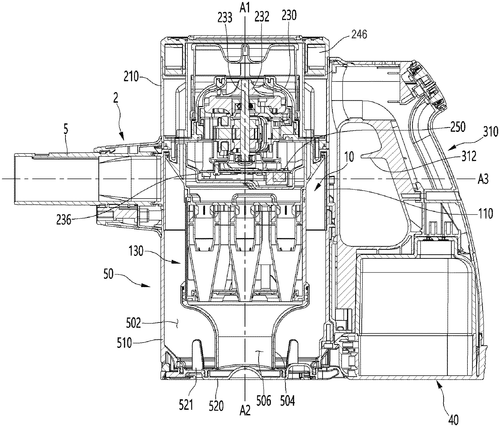
LG Electronics Inc. has recently patented a new cleaner design that boasts an innovative combination of features. The cleaner includes a powerful suction unit with a motor that generates suction force, a dust separation unit with cyclone units for efficient dust removal, a convenient dust container, and a battery for cordless operation. What sets this cleaner apart is the alignment of the impeller's rotational axis and the cyclonic flow axis for optimal performance. Competitors in the cleaning device market, such as Dyson and Hoover, currently offer similar cordless vacuum models with varying degrees of suction power and dust separation mechanisms. LG's new design promises a unique approach that may revolutionize the cleaning experience for consumers. The potential uses for this patent could extend beyond home cleaning to industrial and commercial applications, where efficient and portable cleaning solutions are in high demand. Imagine using this device in large office spaces, warehouses, or even automotive workshops for hassle-free cleaning operations. As we eagerly anticipate the possible development and production of this patented cleaner by LG Electronics Inc., we wonder: Will this innovation set a new standard for cordless cleaning devices, or will it face challenges in practical implementation? Share your thoughts in the comments below.
Abstract
A cleaner includes: a suction unit; a suction motor that generates suction force for sucking air through the suction unit and includes an impeller; a dust separation unit that includes one or more cyclone units generating cyclonic flow to separate dust from air flowing inside through the suction unit; a dust container that stores dust separated by the dust separation unit and is disposed under the suction motor; a battery disposed behind the dust container to supply power to the suction motor; and a handle disposed behind the suction motor, wherein a rotational axis of the impeller and an axis of the cyclonic flow vertically extend and an extension line from the rotational axis of the impeller passes through the one or more cyclone units. A cleaner includes: a suction unit; a suction motor that generates suction force for sucking air through the suction unit and includes an impeller; a dust separation unit that includes one or more cyclone units generating cyclonic flow to separate dust from air flowing inside through the suction unit; a dust container that stores dust separated by the dust separation unit and is disposed under the suction motor; a battery disposed behind the dust container to supply power to the suction motor; and a handle disposed behind the suction motor, wherein a rotational axis of the impeller and an axis of the cyclonic flow vertically extend and an extension line from the rotational axis of the impeller passes through the one or more cyclone units.
US Patent 12053137
LG ELECTRONICS INC.
"LG Electronics Unveils Groundbreaking Robot Design with Advanced Suspension System"
What is this invention?
Robot
In the realm of technology's might,
A robot with a base so bright,
Driving wheel and suspension bar tall,
Connected by a motor to enthrall,
Dancing through the day and night.
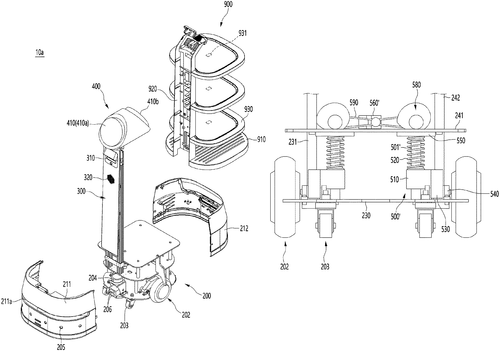
LG Electronics Inc. has revealed a patent for a robot that features an innovative design with a base, driving wheel, plate, suspension bar, slider, bushing top, spring, and motor. The robot's unique features allow for impressive mobility and functionality. This patent brings to mind competitor products such as robotic vacuum cleaners and smart assistant robots. The robot's ability to move smoothly and efficiently thanks to its driving wheel and suspension bar could make it a strong contender in the market. Imagine the potential uses for this robot - it could be utilized for tasks such as household cleaning, delivery services in public spaces, or even surveillance and security purposes. The inclusion of a motor in the design hints at the robot's capability for autonomous movement and operation. Could this robot be the next big thing in the world of robotics? How might consumers and industries benefit from such a versatile and advanced robotic device? What do you think - would you welcome a robot like this into your home or workplace? Share your thoughts in the comments below!
Abstract
A robot according to an embodiment of the present disclosure may comprise: a base; a driving wheel protruding downward from the base; a plate spaced upward from the base; a through hole formed at the plate; a suspension bar including a shaft part rotatably connected to the base and vertically extending upward, and a screw part vertically extending from an upper end of the shaft part toward the through hole; a slider sliding along the shaft part and connected to the driving wheel; a bushing top configured to move up and down along the screw part when the suspension bar rotates; a spring located on an outer circumference of the suspension bar and located between the bushing top and the slider; and a motor disposed above the plate and connected to the screw part through the through hole to rotate the suspension bar. A robot according to an embodiment of the present disclosure may comprise: a base; a driving wheel protruding downward from the base; a plate spaced upward from the base; a through hole formed at the plate; a suspension bar including a shaft part rotatably connected to the base and vertically extending upward, and a screw part vertically extending from an upper end of the shaft part toward the through hole; a slider sliding along the shaft part and connected to the driving wheel; a bushing top configured to move up and down along the screw part when the suspension bar rotates; a spring located on an outer circumference of the suspension bar and located between the bushing top and the slider; and a motor disposed above the plate and connected to the screw part through the through hole to rotate the suspension bar.
US Patent 12054022
LG ELECTRONICS INC.
"Innovative Laundry Machine Patent by LG Electronics Enhances Drainage Performance and Reduces Noise"
What is this invention?
Laundry treatment machine and method for controlling the same
In a laundry machine, so clean,
Pump motor's control is keen,
It slows with the main's pace,
Quieting noise, a grace,
Drainage efficiency, it will glean.
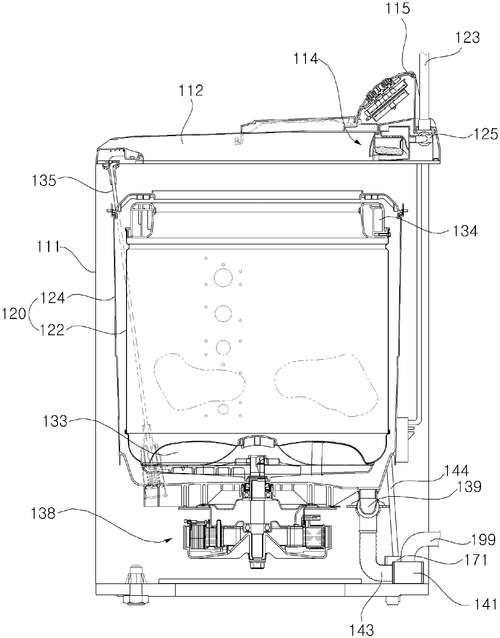
LG Electronics Inc. has recently filed a patent for a laundry treatment machine with a unique feature: a pump motor in the drain pump that adjusts its speed based on the main motor's operation and water level. This innovation not only reduces noise and improves drainage performance but also promises a more efficient laundry experience. Competitors in the laundry appliance industry, such as Samsung and Whirlpool, may have to step up their game if this patent comes to fruition. Imagine a future where your washing machine runs quietly and efficiently, saving both time and energy. This technology could revolutionize the way we do laundry at home. But will LG be able to transform this patent into a tangible product that consumers can purchase? While the concept is promising, practical challenges and market demand will ultimately determine its success. Would you invest in a laundry machine with this innovative feature, or do you prefer traditional models? Let us know in the comments below.
Abstract
The present disclosure relates to a laundry treatment machine. A pump motor provided in a drain pump is controlled to correspond to the operation of the main motor and the water level, so that the pump motor slows down based on the speed of rotation of the main motor and the water level and keeps operating at low speed. Therefore, the pump motor is able to keep operating without stopping operation, and the amount of noise caused by the start-up of the motor is reduced, and the time taken to align the rotor of the motor in position is reduced, thereby reducing drainage time and improving the drainage performance of the drain pump. The present disclosure relates to a laundry treatment machine. A pump motor provided in a drain pump is controlled to correspond to the operation of the main motor and the water level, so that the pump motor slows down based on the speed of rotation of the main motor and the water level and keeps operating at low speed. Therefore, the pump motor is able to keep operating without stopping operation, and the amount of noise caused by the start-up of the motor is reduced, and the time taken to align the rotor of the motor in position is reduced, thereby reducing drainage time and improving the drainage performance of the drain pump.
US Patent 12054872
LG ELECTRONICS INC.
"Innovative Clothes Treatment Apparatus Patent by LG Electronics Inc. Revolutionizes Laundry Care"
What is this invention?
Clothes treatment apparatus
In a cabinet of clothes so neat,
A steam unit makes wrinkles retreat.
A heat pump to air,
Water tank with care,
Sensors ensure fabrics are sweet.
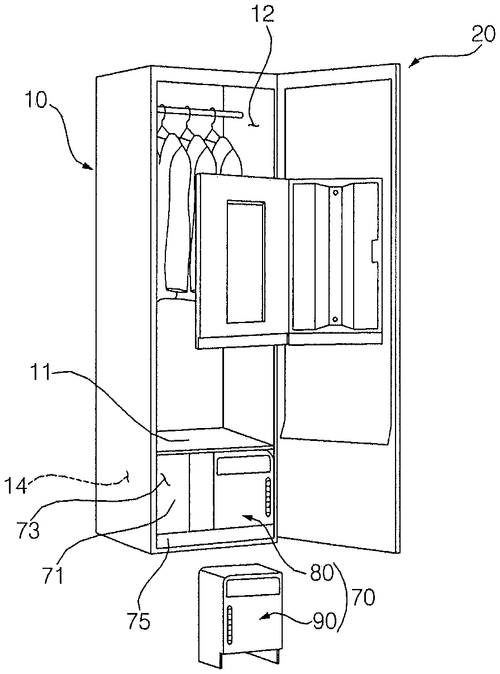
LG Electronics Inc. has patented a new clothes treatment apparatus that promises to revolutionize the way we care for our garments. This innovative invention includes a steam unit, a heat pump unit, a water supply tank, and a drainage tank, all designed to ensure optimal treatment of clothes. Competitors in the garment care industry should take note of this patent, as the incorporation of a heat pump unit for air circulation and conditioning sets this apparatus apart from traditional methods of clothes treatment. The inclusion of water supply and drainage tanks, along with sensors for water levels, adds a level of precision and efficiency to the process. Imagine the possibilities of using this apparatus in your own home - never again worrying about shrinking your favorite sweater or fading your new jeans. With LG's clothes treatment apparatus, you can trust that your garments are being cared for in the best possible way. As we look towards the future of garment care technology, one can't help but wonder: Will this patent pave the way for a new standard in at-home clothes treatment? Share your thoughts in the comments below!
Abstract
A clothes treatment apparatus includes a cabinet, a door, and a steam unit. The clothes treatment apparatus further includes a heat pump unit that is located in the cycle chamber and that is configured to circulate and condition air in the treatment chamber. The clothes treatment apparatus further includes a water supply tank that is installed in the tank installation space, that is connected to the steam unit, and that is configured to supply water to the steam unit. The clothes treatment apparatus further includes a drainage tank that is separably installed in the tank installation space, that is configured to store condensed water generated in at least one of the treatment chamber or the heat pump unit. The clothes treatment apparatus further includes a water supply level sensor. The clothes treatment apparatus further includes a drainage level sensor. A clothes treatment apparatus includes a cabinet, a door, and a steam unit. The clothes treatment apparatus further includes a heat pump unit that is located in the cycle chamber and that is configured to circulate and condition air in the treatment chamber. The clothes treatment apparatus further includes a water supply tank that is installed in the tank installation space, that is connected to the steam unit, and that is configured to supply water to the steam unit. The clothes treatment apparatus further includes a drainage tank that is separably installed in the tank installation space, that is configured to store condensed water generated in at least one of the treatment chamber or the heat pump unit. The clothes treatment apparatus further includes a water supply level sensor. The clothes treatment apparatus further includes a drainage level sensor.
US Patent 12054876
HUAWEI TECHNOLOGIES CO., LTD.
"Revolutionizing Radar: Huawei Patents Innovative Signal Processing Method for Enhanced Vehicle Radar Systems"
What is this invention?
Radar signal processing method and apparatus, and storage medium
In the land of radar and waves so bright,
A method and apparatus shine with might,
First radar's angle set just right,
Opposite detection in the night,
Orthogonal angles guide their flight.
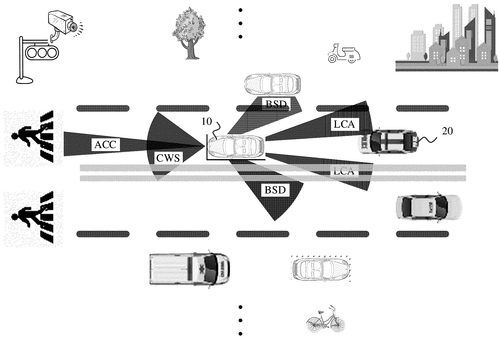
In a recent patent application from Huawei Technologies Co., a new radar signal processing method has been unveiled. This innovative approach involves determining the polarization direction of a radar located on a vehicle and transmitting signals accordingly. What sets this method apart is the specific alignment of the radar's detection direction and polarization angle, with respect to a second radar on the same vehicle. The orthogonal relationship between the two angles aims to optimize radar performance in detecting objects from different perspectives. Competitors in the radar technology market, such as Bosch and Continental, offer similar radar systems for vehicles, but Huawei's unique polarization direction approach could potentially revolutionize radar signal processing. By enhancing object detection accuracy and minimizing interference, this method could improve overall safety features in autonomous driving systems. Imagine a future where cars equipped with Huawei's radar technology can seamlessly navigate complex environments with precision and reliability, ensuring a smoother driving experience for passengers. How might this advanced radar system impact the development of autonomous vehicles and contribute to road safety?
Abstract
A radar signal processing method and an apparatus, and a storage medium that are applied to a first radar. The method includes: determining that a polarization direction of the first radar is a first angle, where the first radar is located at a first vehicle; and transmitting a radar signal based on the polarization direction of the first radar, where a detection direction of the first radar is opposite to a detection direction of a second radar located at the first vehicle, and a polarization direction of the second radar is a second angle; and the first angle and the second angle are orthogonal. A radar signal processing method and an apparatus, and a storage medium that are applied to a first radar. The method includes: determining that a polarization direction of the first radar is a first angle, where the first radar is located at a first vehicle; and transmitting a radar signal based on the polarization direction of the first radar, where a detection direction of the first radar is opposite to a detection direction of a second radar located at the first vehicle, and a polarization direction of the second radar is a second angle; and the first angle and the second angle are orthogonal.
US Patent 12055625
HUAWEI TECHNOLOGIES CO., LTD.
"Huawei's Innovative Mobile Terminal Design Pushes Boundaries with Slimmer Display Module Border"
What is this invention?
Mobile terminal
In a mobile terminal, technology sublime,
With modules and hinges, a design so fine,
The display and host, connected in line,
An innovative solution, so cleverly designed,
Reduced borders for a sleek, modern shine.
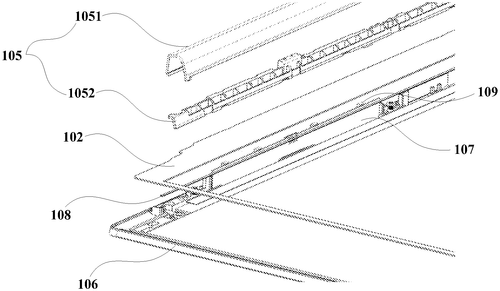
A new patent from HUAWEI TECHNOLOGIES CO., LTD. introduces a mobile terminal with a sleek design that aims to reduce the width of the bottom border of the display module. This innovation includes a hinge that connects the display module and the host module, positioned strategically on the bottom border. The display module features a top cover with an accommodating cavity housing a screen body, screen drive plate, and screen cover plate. The hinge cover overlaps part of the screen cover plate, allowing for a more compact design. This patent sets itself apart from current competitor products by focusing on maximizing display space while minimizing the overall footprint of the device. The potential uses for such a design could include creating smartphones with larger screens in a more manageable form factor or enhancing the portability of foldable devices by reducing their size when folded. However, as with many patents, the question remains: will this innovative design make it from concept to consumer hands? How important is a narrow border design to you when choosing a mobile device? Share your thoughts in the comments below.
Abstract
A mobile terminal includes a display module, a host module, and a hinge used to connect the display module and the host module. The hinge is disposed on a bottom border of the display module. The display module includes a top cover and a hinge cover that covers the hinge, and the top cover has an accommodating cavity. A screen body, a screen drive plate, and a screen cover plate that covers the screen body are accommodated in the accommodating cavity, and a part of the screen cover plate extends into a cavity of the hinge cover, so that the hinge cover overlaps the part of the screen cover plate. In this technical solution, a width of the bottom border of the display module can be effectively reduced, to facilitate implementation of a narrow border design of the display module. A mobile terminal includes a display module, a host module, and a hinge used to connect the display module and the host module. The hinge is disposed on a bottom border of the display module. The display module includes a top cover and a hinge cover that covers the hinge, and the top cover has an accommodating cavity. A screen body, a screen drive plate, and a screen cover plate that covers the screen body are accommodated in the accommodating cavity, and a part of the screen cover plate extends into a cavity of the hinge cover, so that the hinge cover overlaps the part of the screen cover plate. In this technical solution, a width of the bottom border of the display module can be effectively reduced, to facilitate implementation of a narrow border design of the display module.
US Patent 12055982
HUAWEI TECHNOLOGIES CO., LTD.
"Pioneering Transmission Policy Matching Patent Unveiled by HUAWEI TECHNOLOGIES CO., LTD."
What is this invention?
Data transmission method, electronic device, and computer-readable storage medium
In a world of digital terrain,
Preset policy library to detain,
Hardware info and data in sync,
Matching transmission, no kink,
Query result back, no data drain!
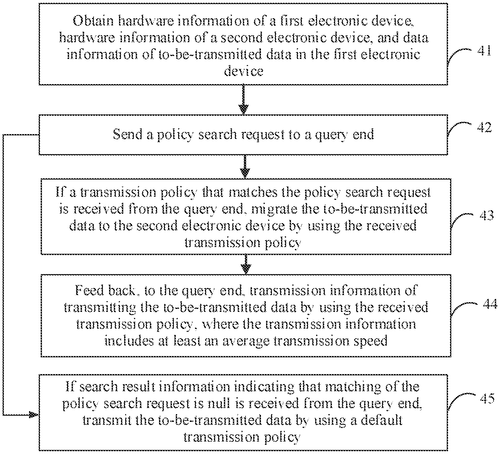
A new patent filed by HUAWEI TECHNOLOGIES CO., LTD. describes a method that involves searching a library of preset policies in response to a query request related to data transmission. This method aims to match the query request with a suitable transmission policy based on hardware information of the transmitting and receiving ends, as well as data information of the data to be transmitted. Once a match is found, the query result is fed back to the transmitting end. This innovative approach by Huawei could potentially streamline data transmission processes by ensuring that the most appropriate transmission policy is applied based on specific hardware and data characteristics. Competitors in the tech industry, such as Cisco and Nokia, may need to take note of this development as it could offer a new level of efficiency in data transmission protocols. Imagine the possibilities of this technology in optimizing data transfers in various industries, from telecommunications to healthcare to finance. Could this method pave the way for more customized and efficient data transmission solutions tailored to specific needs and requirements? How might this innovation impact the future of data communication systems?
Abstract
A method includes searching, in response to a received policy query request, a preset policy library for a transmission policy that matches the policy query request, wherein the policy query request comprises hardware information of a transmitting end, hardware information of a receiving end, and data information of to-be-transmitted data in the transmitting end, and wherein the data information comprises a total data volume of the to-be-transmitted data, a data category comprised in the to-be-transmitted data, and a data volume of each data category, and feeding back a query result of the policy query request to the transmitting end. A method includes searching, in response to a received policy query request, a preset policy library for a transmission policy that matches the policy query request, wherein the policy query request comprises hardware information of a transmitting end, hardware information of a receiving end, and data information of to-be-transmitted data in the transmitting end, and wherein the data information comprises a total data volume of the to-be-transmitted data, a data category comprised in the to-be-transmitted data, and a data volume of each data category, and feeding back a query result of the policy query request to the transmitting end.
US Patent 12056087
HUAWEI TECHNOLOGIES CO., LTD.
"Revolutionizing Virtualized Network Function Deployment: Huawei's Innovative Method"
What is this invention?
Method and apparatus for deploying virtualised network function
In VNF deployment, a manager named VNFM,
Obtains VNFD for a virtualized gem,
With primary and secondary files, all in a blend,
Association and mapping, they all extend,
To deploy the VNF, the VNFM does strive, amen.
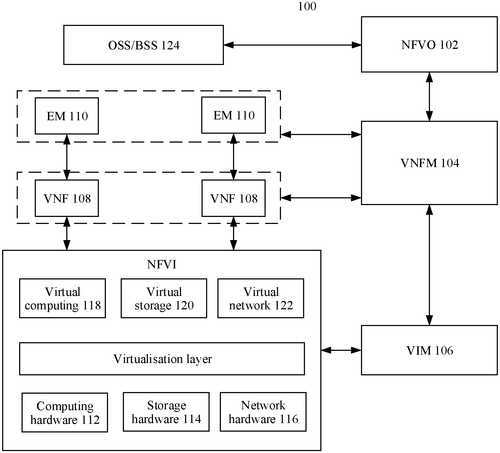
In a recent patent filed by HUAWEI TECHNOLOGIES CO., LTD., a method of deploying a virtualised network function (VNF) has been described. This innovative process involves a virtual network function manager (VNFM) obtaining a virtualized network function descriptor (VNFD) containing primary and secondary files with specified mapping relationships. The VNFM then selects a target file from the secondary files based on certain parameters and deploys the VNF accordingly. This patent showcases Huawei's ongoing commitment to advancing network technology in the digital age. Competitors in the telecommunications industry, such as Cisco and Nokia, will no doubt be keeping a close eye on developments like this. Potential uses for this technology could range from enhancing network efficiency and flexibility to streamlining the deployment of virtualized services in various industries. The implications for the future of network management are significant. As we consider the impact of this patent, one can't help but wonder: How might this method of deploying virtualized network functions revolutionize the way we approach network infrastructure in the years to come? Share your thoughts in the comments below.
Abstract
In a method of deploying a virtualised network function (VNF), a virtual network function manager (VNFM) obtains a virtualized network function descriptor (VNFD) that includes a primary file and one or more secondary files that have a mapping relationship with the primary file. The primary file includes a deployment parameter of each secondary file, and a association relationship indicating that a value of a flavour parameter of the VNF is associated with the deployment parameter of the secondary file. The VNFM then determines a target file from the one or more secondary files based on the value of the flavour parameter of the VNF and deploy S the VNF based on the association relationship and a mapping relationship between the primary file and the target file. In a method of deploying a virtualised network function (VNF), a virtual network function manager (VNFM) obtains a virtualized network function descriptor (VNFD) that includes a primary file and one or more secondary files that have a mapping relationship with the primary file. The primary file includes a deployment parameter of each secondary file, and a association relationship indicating that a value of a flavour parameter of the VNF is associated with the deployment parameter of the secondary file. The VNFM then determines a target file from the one or more secondary files based on the value of the flavour parameter of the VNF and deploy S the VNF based on the association relationship and a mapping relationship between the primary file and the target file.
US Patent 12056094
HUAWEI TECHNOLOGIES CO., LTD.
"Huawei Patent Revolutionizes Word Completion Technology with Improved Trie Method"
What is this invention?
Word completion method and apparatus
There once was a method so grand,
Aiding users to perfectly understand,
Based on an improved trie,
Hot words make the completion fly,
Efficiency soaring to beat the band.
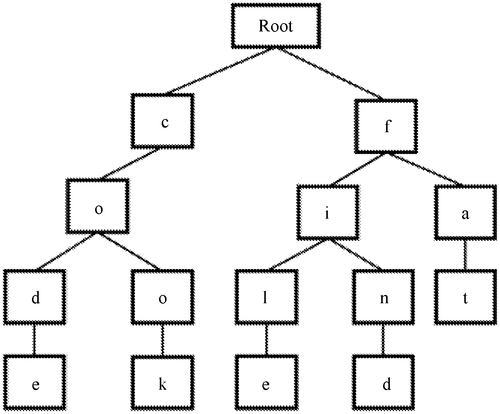
In a recent patent by Huawei Technologies Co., Ltd., a novel word completion method and apparatus have been described. This innovative approach aims to enhance word completion efficiency in a search scenario by utilizing an improved trie structure. Hot words strategically stored within the trie nodes assist in providing accurate word suggestions to users. Competitors in the field, such as Google's predictive text feature and Apple's QuickTy. pe, may face stiff competition if Huawei successfully implements this technology. Imagine the convenience of seamlessly completing words while typing on your smartphone or computer, all thanks to this advanced word completion method. The potential uses of this invention are vast, ranging from improving user experience in search engines to enhancing text messaging and email composition. By avoiding the common issue of recommending irrelevant words based on short character strings, Huawei's innovation shows promise in revolutionizing word completion technology. As we look towards a future where human-machine interaction continues to evolve, one cannot help but wonder: How will this enhanced word completion method impact the way we communicate and interact with our devices? Share your thoughts in the comments below.
Abstract
A word completion method and apparatus are described. The method is applied to a search scenario and is used to complete an incomplete word entered by a user. The method is based on an improved trie. Hot words are stored in some nodes of the trie. In the word completion method, a target node that matches a character string is searched in the trie, and at least one completed word is output to a user based on a hot word stored in the target node. Word completion efficiency is improved, and a case in which a word is recommended to a user when the user enters an excessively short character string is avoided. A word completion method and apparatus are described. The method is applied to a search scenario and is used to complete an incomplete word entered by a user. The method is based on an improved trie. Hot words are stored in some nodes of the trie. In the word completion method, a target node that matches a character string is searched in the trie, and at least one completed word is output to a user based on a hot word stored in the target node. Word completion efficiency is improved, and a case in which a word is recommended to a user when the user enters an excessively short character string is avoided.
US Patent 12056192